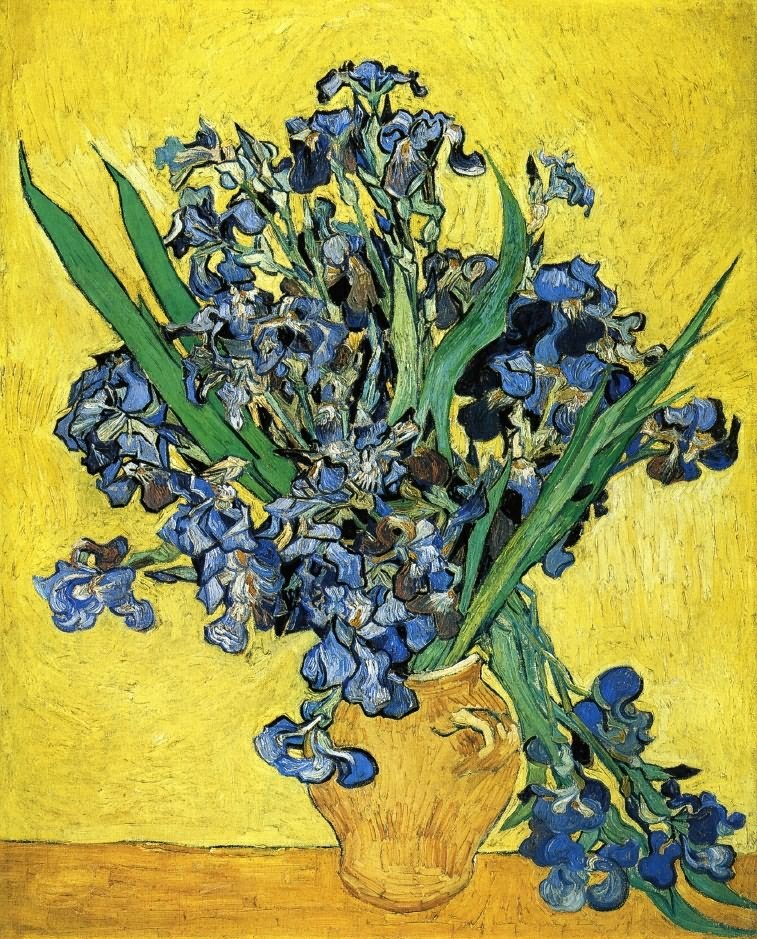Still Life with Irises
Appreciation

Still Life with Irises Nederland Vincent van Gogh Gallery and Appreciation
Still Life: Vase with Irises Against a Yellow Background stands out as one of Vincent van Gogh's most well known floral still life paintings.
The work, along with its companion piece Still Life: Vase with Irises, is unusual in that it's one of the few still lifes painted by Van Gogh during his stay at the asylum in Saint-Rémy. Van Gogh painted still life works throughout his ten year career as an artist--from the earliest works in Etten, through to the final works he executed shortly before his death in 1890.
Interestingly, the one period in which Van Gogh produced very few still lifes was during his stay in Saint-Rémy. Perhaps this was because the surrounding landscape of Saint-Rémy was so inviting--the olive groves and soaring cypresses were far more interesting to Van Gogh who so loved to paint outdoors. Perhaps Vincent was anticipating his upcoming move from the asylum--his home for more than a year--to Auvers-sur-Oise in the north (where Van Gogh would rediscover his love of still life painting).
Of Still Life: Vase with Irises Against a Yellow Background Van Gogh wrote:
At present all goes well, the whole horrible attack has disappeared like a thunderstorm and I am working to give a last stroke of the brush here with a calm and steady enthusiasm. I am doing a canvas of roses with a light green background and two canvases representing big bunches of violet irises, one lot against a pink background in which the effect is soft and harmonious because of the combination of greens, pinks, violets. On the other hand, the other violet bunch (ranging from carmine to pure Prussian blue) stands out against a startling citron background, with other yellow tones in the vase and the stand on which it rests, so it is an effect of tremendously disparate complementaries, which strengthen each other by their juxtaposition.
Letter 633 Auvers-sur-Oise 11 or 12 May 1890
As mentioned above, Van Gogh may have painted this work in subconscious anticipation of his departure from the asylum at Saint-Rémy. But this still life also has roots in Van Gogh's past approach to his works, both in terms of the composition of the painting as well as his life-long interest in the effective use of contrasting colours.
In his catalogue for the 1986 exhibition Van Gogh in Saint-Rémy and Auvers Ronald Pickvance wrote about the still lifes Van Gogh produced during this period:
In these formalistic color exercises he dispensed with a loaded brush and thick impasto, spreading the paint discreetly and carefully plotting the shapes. In the present painting, where the interplay of yellows, the proportion of the table in relation to the background, and the asymmetrical placing of the vase subtly echo one of the Arles Sunflowers (F 454), he actually painted the flowers, vase, and tabletop before adding the background in and around the established shapes.1
Indeed, the composition of the work is highly reminiscent of the famous sunflower series, but here Van Gogh also makes wonderful use of the contrasting colours laid out on the canvas.
The effective interplay of contrasting colours was a subject that interested Vincent as well as Theo van Gogh throughout their careers. In late 1889 Theo wrote to his brother:
One can get no idea of the force of the colours, which Monticelli was one of the first to use, availing himself of a contrast in order to arrive at a strong effect while preserving harmony.
Letter T22 Paris 22 December 1889
Vincent himself wrote about his use of contrasting colours on a number of occasions2:
But I have made a series of colour studies in painting, simply flowers, red poppies, blue corn flowers and myosotys, white and rose roses, yellow chrysanthemums--seeking oppositions of blue with orange, red and green, yellow and violet seeking les tons rompus et neutres to harmonize brutal extremes. Trying to render intense colour and not a gray harmony.
Letter 459a (to Horace Mann Livens) Paris August/October, 1886
It's interesting to note that Van Gogh's interest in the specific colour contrast of violet and yellow dates back to his Paris period. Van Gogh again mentions the violet/yellow colour contrast in a letter dated from the same period:
As for my work, I painted the pendant to those flowers which you have. A branch of white lilies--white, pink, green--against black, something like black Japanese lacquer inlaid with mother-of-pearl, which you know--then a bunch of orange tiger lilies against a blue background, then a bunch of dahlias, violet against a yellow background, and a red gladioli in a blue vase against light yellow.
Letter 460 Paris August, 1886
And then, in a letter to his sister, Wilhelmina:
Last year I painted hardly anything but flowers in order to get accustomed to using a scale of colours other than gray--namely pink, soft and vivid green, light blue, violet, yellow, orange, rich red.
Letter W1 Paris Summer or fall, 1887
Both Vincent and his brother Theo van Gogh held strong opinions regarding the use of contrasting colours in art. If used effectively, these contrasts need not produce a jarring and dissonant interplay on the canvas, but rather--as both the Van Gogh brothers would write--the result would be a powerful visual "harmony".